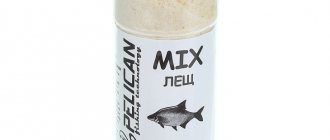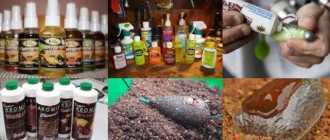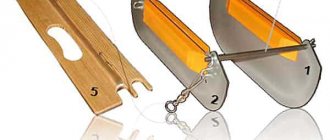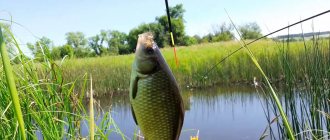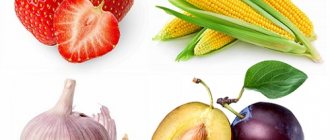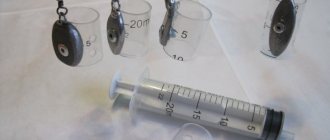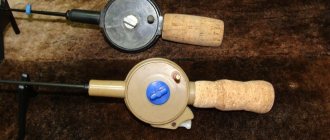Flavors for fishing are a relatively new trend in sport and recreational fishing, which has managed to gather many supporters over the course of several years. Today, many people use special substances designed to attract fish. They can be branded in the form of liquids, powders and sprays, or homemade.
Ready-made store-bought flavors contain the optimal ratio of aromatic components to attract a particular type of fish; the fisherman just has to choose the one he needs and apply it correctly. You can treat baits with proprietary compounds or add them to the bait mixture to guarantee a good catch. However, not every fisherman is ready to pay money for a small but expensive jar of the substance, and besides, there are now a lot of fakes that have no effect on fishing. Buying such a “magic remedy” means throwing your money away. That is why many fishing enthusiasts experiment with different scents, select effective combinations and prepare flavors at home.
Aromas used in fishing
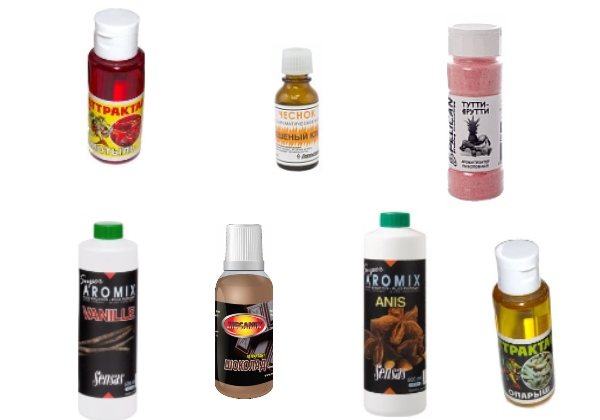
Among the variety of attractants, the following flavors are most often used for fishing:
- Anise. A flavoring agent known to many fishermen since Soviet times. It is considered the best for catching roach. Almost all carp fish from crucian carp to bream react to anise. It is often added to branded baits.
- Banana and peach. These smells are used mainly for carp fishing in the summer.
- Chocolate. Excellent for bream, silver bream and sop. Other cyprinids are also tempted by this aroma.
- Garlic. One of the truly popular scents. Neither crucian carp nor bream can resist him. Used mainly in cold water when fishing with a feeder or float.
- Caramel and vanilla. Universal flavorings for carp fish. Bream, roach, and crucian carp are partial to these smells.
- Cutting white fish. One of the rare attractants for attracting catfish and burbot.
- Coriander. Used to flavor bait intended for catching river fish on a feeder.
- Red worm. A rather disgusting smell from a human point of view, but it attracts fish and can be used to attract predators - rotan, perch and even catfish.
- Maggot. Attractant for crucian carp and roach. Can seduce sopa and silver bream. Carp also loves it.
- Halibut. It works very well in attracting predators to the bait; we use it for catching catfish.
- Strawberry and tutti-frutti. Popular summer flavors for carp and crucian carp can be used when fishing for bream on a feeder. These additives are often included in branded baits to attract fish and improve the bite.
- Honey and gingerbread. A aroma that is loved not only by children, but also by carp fish. Bream, tench, crucian carp, roach - this is an incomplete list of his admirers.
- Squid. In addition to catfish and burbot, it attracts trophy carp. Grass carp will also be tempted by this smell.
- Corn. One of the champions in carp fishing, it attracts bream and roach.
- Sunflower. Widely used in fishing, used even in winter when fishing for bream and crucian carp.
- Dill and fennel. Used for all types of carp fish, this smell will not spoil the appetite of catfish.
How to choose a flavor
The choice of flavor depends not only on seasonality; you also need to take into account the taste preferences of the fished object. Let's consider what the main fish of our reservoirs like.
Bream, bream, roach, silver bream and some of their closest relatives can be tempted:

vanilla;- strawberries;
- pear;
- honey;
- cinnamon;
- anise;
- garlic
"Branded" smells
The most famous in the fishing community are Sensas flavors.
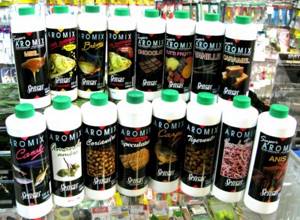
In addition to this French manufacturer, one can note the American “Megastrike” and the English “Dynamite Baits”.
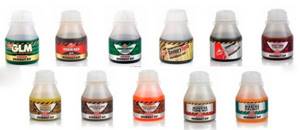
Polish actively promotes its products.
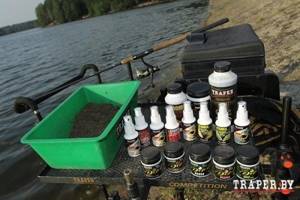
The Russian brand UNIKORM "Aromatics" produces products almost exactly repeating Sensas flavors. So these attractants can become a budget replacement for Russian fishermen.

Fast and efficient
Sensas fragrance spray is produced in France. Small 75 ml bottles contain liquid intended for each type of fish separately. Each of them has its own scent. Flavorings for carp, crucian carp and other large fish smell like fishmeal, roach and bream will like earthworms, and barbel will fall for the aroma of cheese. But there is a universal option - Sensas Bombix Brasem. It is suitable for many types of predatory fish. Fishermen speak positively about the sprays from this manufacturer. But they advise you to experiment with smells. There have been cases when a scent intended for one type of fish stimulated the bite of another.
We cook ourselves
Just as the hero in the famous film “Perfume” found a way to retain the smell, so the fishermen managed to learn how to prepare flavors themselves. To do this, you need to use the recipes given below. The basis of flavorings is sugar syrup. Then odorous substances are introduced into the syrup, and it preserves their odors. Below we will describe some recipes for preparing such compositions yourself.
Steps for making your own flavors:
- Pour one kilogram of granulated sugar into a clean bowl.
- Fill with 750 grams of clean water. It is better to take spring or bottled.
- Place the pan on low heat and cook, stirring constantly until the sugar is completely dissolved. During the entire process, remove the foam with a spoon. Do not rinse the spoon, wipe it dry with a clean napkin.
- Add the aromatic additive to the syrup and cook until it dissolves.
- Store the syrup in a cool, dark place.
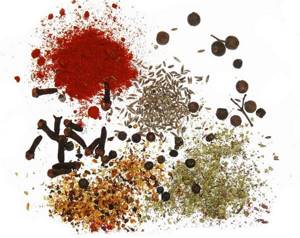
Approximate composition of additives per liter of syrup:
- Vanilla – 3-4 pods, vanillin – 1 sachet or 4 sachets of vanilla sugar.
- Cocoa or chocolate – 150 grams.
- Cinnamon, coriander, cloves - 2 teaspoons.
Syrup flavorings are best used for dipping baits. By diluting this composition with water, the bait can be flavored. In addition to sugar syrup, you can preserve flavors and prepare flavorings using an alcohol base. To do this, dry spices are poured into a dark glass container and filled with alcohol or vodka. This is infused for three weeks in a dark place. If fresh ingredients - berries and fruits - are poured with alcohol, then to avoid the fermentation process you need to add a teaspoon of salt to a glass of liquid.
Let's look at what ingredients can be used for alcohol infusion:
- garlic;
- dill;
- vanilla;
- carnation;
- cocoa;
- anise;
- mint;
- cinnamon;
- honey.
In addition to these components, you can use many other plants with your favorite fish scents. You can also try to create mixtures of aromas, because creativity is always welcome in fishing, and it may happen that someone will reveal to the world the most killer aromatic mix. It is better to use an alcohol solution as a spray, while the alcohol evaporates, but the preserved aroma remains.
The blood of domestic animals and birds can be considered as a homemade dip. For preservation, it is simply frozen, and when fishing, it thaws and soaks the bait. You can dip a foam fish in blood when spinning fishing for a predator - pike perch, burbot or catfish.
You can prepare aromatic herbs for fishing by drying them. In the gardens of our country the following attractant plants are often grown:
- dill;
- fennel;
- peppermint;
- lemon balm;
- garlic;
- anise;
- coriander;
- cumin and others.
After drying, these herbs can be used to prepare an alcoholic infusion, or crushed into groundbait. It is better to store dry herbs in closed glass jars, such as coffee jars.
How to make it yourself
Many advanced fishermen have learned to make both dry and liquid flavors for fishing with their own hands. Many aromatic plants grown in summer cottages are suitable for preparing dry mixtures. These are fennel, lemon balm, coriander, mint, cumin, dill, garlic, anise. You just need to collect them, dry them completely and grind them. Everyone calculates the proportions themselves.
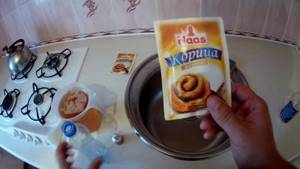
An alternative option is alcohol flavorings for fishing, which, like dry ones, are stored for quite a long time. You can pour dried herbs (for example, dill, cloves, anise) with alcohol (vodka), shake the contents of the container thoroughly and leave for 2.5-3 weeks. It is important that the jar is made of dark glass, which protects the product from sunlight. The components of homemade flavoring, as well as their concentration, can be changed at your discretion.
Use of dry flavors
Dry aromatic substances are mainly added to homemade bait mixtures. If the supplement is branded, then this is very easy to do, you just need to follow the instructions on the product packaging.
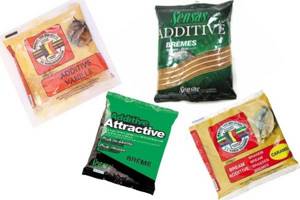
When using your own dried and crushed plants, you need to be guided by your sense of smell and intuition. There are no exact recommendations here, since the compositions differ in the set of herbs, degree of dryness and concentration of aromatic substances. The same applies to flavoring bait with ground coffee, cocoa powder or vanilla sugar and cinnamon. The angler himself decides what proportions to follow.
Making your own flavors
Video about flavorings and how you can prepare flavorings for catching peaceful fish yourself.
What can be used as raw material for home-made flavors?
There are a huge number of different recipes for fish flavorings, which you can easily make yourself. It all depends on what kind of fish you are going to catch. To create attractants at home, you can use the following ingredients:
- sugar;
- honey;
- cocoa;
- garlic;
- halva;
- vanillin;
- carnation;
- dill;
- fennel;
- cardamom and much more.
In this case, it is difficult to imagine the composition of a flavoring without the use of food flavorings, for example, flaxseed, sunflower, hemp and dill. Moreover, there are medications that also have a positive effect on aquatic life. So, castor oil, valerian, fish oil and even the well-known “Star” balm are good options.
Several recommendations for the use of home attractants
- It is important to maintain a low concentration of the substance. Since a sharp and strong aroma can act opposite to the desired result, and will only scare away the fish.
- If you plan to use a flavor during the warm season of the year, then it is better to take alcohol, oil and glycerin attractants.
- For the winter months and cold weather, it is recommended to use exclusively alcohol flavors. Pay special attention to attractants of animal origin. This could be fish oil, canned food, dried blood, bloodworms, and the like.
Liquid flavors: dips and sprays
Amateurs and professionals of carp fishing have introduced into the fishing community the concept of “dips”, flavoring agents in which boilies are immersed. Literally translated from English, this term means “depth.”
Carp anglers dip their boilies into the dips. In addition to a pleasant and rich smell, dips have a good taste for fish. Syrups retain this taste and aroma. When approached by a tasty boilie, even enhanced with dip, the carp will certainly want to feast on it.

In feeder fishing, dip baits are also used. Vegetable baits are dipped in sweet solutions and delivered to the fishing site. The aroma of the dip should distinguish the bait from the background of the groundbait, so the bait attractant should be different from the dip.
Unlike feeder and carp fishing, when float fishing, deepening is not yet widely used due to the point supply of the nozzle. Here, the best flavoring option would be to add the aroma directly to the nozzle when preparing it.
To flavor baits that should not be dipped into the dip, such as maggots, worms, and semolina, spraying is used. When the bait is delivered to the fishing site with a feeder, the alcohol from the spray disappears, but the smell of the attractant remains.
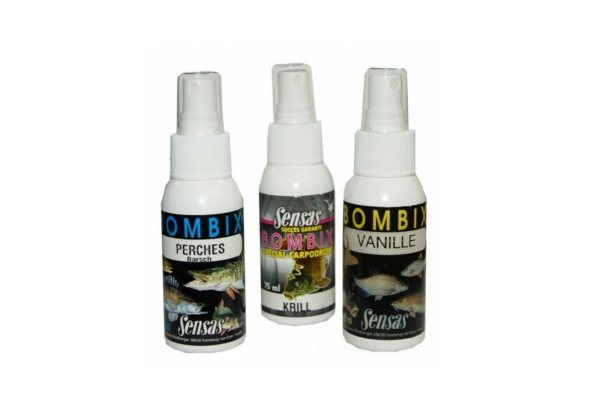
It is useful to spray baits with meat or fish flavors for predators, especially for catfish or burbot, which use their sense of smell in their hunt.
Types of attractants
Experienced fishermen prepare a certain amount of bait and add flavorings to it. The main thing is not to put more than you should, otherwise the effect will be exactly the opposite. Flavors for fishing are used at any time of the year. The main thing is that the bait slowly sinks under the water so that the smell spreads over a considerable distance. If you apply the flavoring in the form of a paste, it will stick to the bait and will ensure that it sinks slowly. Syrups envelop tackle and bait, sticky and indelible, which means they guarantee the stability of the aroma. You can also use liquid attractants or sprays.
Odors for certain fish species
Crucian carp loves maggots treated with anise spray. But the dough, on the contrary, is immersed in a dip with the smell of maggots. In general, when fishing for crucian carp, especially with a feeder, aromatization is very important. The bite of our picky fish is unpredictable neither in winter nor in summer. Garlic works well on crucian carp in cold water.
At the beginning of the season, bream prefer spicy smells: garlic, coriander, anise. Then corn, vanilla and caramel work best.
Which flavoring does a roach prefer? In winter they add sunflower, in spring anise and garlic, in summer any berry aromatics.
Hungry fish
To take your bait, it must be hungry. If her appetite is not particularly good, it can be stimulated, for example, by using FishHungry. This activator can be added to any natural bait, treated with artificial bait, and also diluted in water, into which the live bait can then be dipped. The package contains 5 ampoules. One ampoule is designed for 2-2.5 kg of bait or 0.5 liters of water. Suitable for use in all types of reservoirs and at any time of the year. This activator is suitable for all types of fish. It contains concentrated essential oils and synthesized pheromones. Under the influence of the drug, the fish's appetite increases, they strive for the place where the activator is located, and actively eat everything edible that appears on their way, including bait.
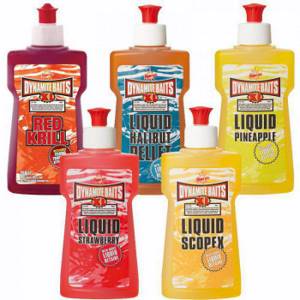
General principles of flavoring
It is generally accepted that during the spring fishing season, fish are more inclined towards spicy aromas; as the water warms up, sweet aromas begin to prevail. Closer to autumn, fish tastes again change towards spicy tastes. Animal scents also work better in cold water.
But, for example, they can be used to attract catfish in the summer. Fruit components are in demand throughout the open water season, but their use is desirable as similar fruits ripen in the current fishing region. In the summer, especially when fishing with long casting - for a match or a feeder - it is better to use dips with sweet aromas: tutti-frutti, caramel, vanilla. At the end of summer, fruity aromas such as strawberry, cherry, peach, and banana are popular.
In general, on any fishing trip you need to have a set of different scents with you. By varying them, you can choose the one that will help you improve your bite and enjoy your favorite hobby.
Main types of flavors for fishing
All existing types of flavorings can be divided into several according to certain criteria. That is why, before you go fishing, you should determine the specific species that will give the bait an aroma that will attract the inhabitants of the reservoir. Mixtures will be effective only in a properly selected complex.
By purpose they are divided as follows:
- for bait;
- for nozzle.
The two selected types differ in that aromas for attachments are made for substances that change the smell and taste of the mixture.
Purpose of flavors for fishing:
- general purpose. In this case we are talking about such smells (spices, strawberries, cocoa and others);
- intended purpose. In this case, each composition is produced for a specific type, for example, products are produced for catching roach, bream, crucian carp and other representatives.
Sprinkle or pour
Not very convenient to use, but, according to some fishermen, more natural attractants are dry flavors. These fishing activators should be added to the bait 1-2 weeks before fishing. Really not very convenient. In addition, this leaves no room for maneuver, that is, using such flavorings, the fisherman will not be able to navigate on the spot and change the aroma, depending on the behavior of the fish. Liquid attractants give off their aroma to the bait faster. But their stability depends on the basis on which they are made. Alcohols, of course, evaporate faster than essential oils. Attractants are also produced in the form of a gel.
